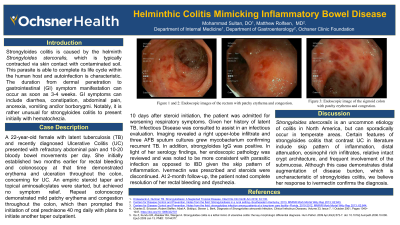Back


Poster Session B - Monday Morning
Category: Colon
B0153 - Helminthic Colitis Mimicking Inflammatory Bowel Disease
Monday, October 24, 2022
10:00 AM – 12:00 PM ET
Location: Crown Ballroom

Has Audio

Mohammad T. Sultan, DO, MS
Ochsner Clinic Foundation
New Orleans, LA
Presenting Author(s)
Mohammad T. Sultan, DO, MS1, Matthew Rolfsen, MD2
1Ochsner Clinic Foundation, New Orleans, LA; 2Ochsner Health, New Orleans, LA
Introduction: Strongyloides colitis is caused by the helminth Strongyloides stercoralis, which is typically contracted via skin contact with contaminated soil. This parasite is able to complete its life cycle within the human host and autoinfection is characteristic. The duration from dermal penetration to gastrointestinal (GI) symptom manifestation can occur as soon as 3-4 weeks. GI symptoms can include diarrhea, constipation, abdominal pain, anorexia, vomiting and/or borborygmi. Notably, it is rather unusual for strongyloides colitis to present initially with hematochezia.
Case Description/Methods: A 22-year-old female with latent tuberculosis (TB) and recently diagnosed Ulcerative Colitis (UC) presented with refractory abdominal pain and 10-20 bloody bowel movements per day. She initially established two months earlier for rectal bleeding and colonoscopy at that time demonstrated erythema and ulceration throughout the colon, concerning for UC. An empiric steroid taper and topical aminosalicylates were started, but achieved no symptom relief. Repeat colonoscopy demonstrated mild patchy erythema and congestion throughout the colon, which then prompted the initiation of oral prednisone 40 mg daily with plans to initiate another taper outpatient.
10 days after steroid initiation, the patient was admitted for worsening respiratory symptoms. Given her history of latent TB, Infectious Disease was consulted to assist in an infectious evaluation. Imaging revealed a right upper-lobe infiltrate and three AFB sputum cultures grew mycobacterium confirming recurrent TB. In addition, strongyloides IgG was positive. In light of her serology findings, her endoscopic pathology was reviewed and was noted to be more consistent with parasitic infection as opposed to IBD given the skip pattern of inflammation. Ivermectin was prescribed and steroids were discontinued. At 2-month follow-up, the patient noted complete resolution of her rectal bleeding and dyschezia.
Discussion: Strongyloides stercoralis is an uncommon etiology of colitis in North America, but can sporadically occur in temperate areas. Certain features of strongyloides colitis that contrast UC in literature include skip pattern of inflammation, distal attenuation, eosinophil rich infiltrates, relative intact crypt architecture, and frequent involvement of the submucosa. Although this case demonstrates distal augmentation of disease burden, which is uncharacteristic of strongyloides colitis, we believe her response to ivermectin confirms the diagnosis.

Disclosures:
Mohammad T. Sultan, DO, MS1, Matthew Rolfsen, MD2. B0153 - Helminthic Colitis Mimicking Inflammatory Bowel Disease, ACG 2022 Annual Scientific Meeting Abstracts. Charlotte, NC: American College of Gastroenterology.
1Ochsner Clinic Foundation, New Orleans, LA; 2Ochsner Health, New Orleans, LA
Introduction: Strongyloides colitis is caused by the helminth Strongyloides stercoralis, which is typically contracted via skin contact with contaminated soil. This parasite is able to complete its life cycle within the human host and autoinfection is characteristic. The duration from dermal penetration to gastrointestinal (GI) symptom manifestation can occur as soon as 3-4 weeks. GI symptoms can include diarrhea, constipation, abdominal pain, anorexia, vomiting and/or borborygmi. Notably, it is rather unusual for strongyloides colitis to present initially with hematochezia.
Case Description/Methods: A 22-year-old female with latent tuberculosis (TB) and recently diagnosed Ulcerative Colitis (UC) presented with refractory abdominal pain and 10-20 bloody bowel movements per day. She initially established two months earlier for rectal bleeding and colonoscopy at that time demonstrated erythema and ulceration throughout the colon, concerning for UC. An empiric steroid taper and topical aminosalicylates were started, but achieved no symptom relief. Repeat colonoscopy demonstrated mild patchy erythema and congestion throughout the colon, which then prompted the initiation of oral prednisone 40 mg daily with plans to initiate another taper outpatient.
10 days after steroid initiation, the patient was admitted for worsening respiratory symptoms. Given her history of latent TB, Infectious Disease was consulted to assist in an infectious evaluation. Imaging revealed a right upper-lobe infiltrate and three AFB sputum cultures grew mycobacterium confirming recurrent TB. In addition, strongyloides IgG was positive. In light of her serology findings, her endoscopic pathology was reviewed and was noted to be more consistent with parasitic infection as opposed to IBD given the skip pattern of inflammation. Ivermectin was prescribed and steroids were discontinued. At 2-month follow-up, the patient noted complete resolution of her rectal bleeding and dyschezia.
Discussion: Strongyloides stercoralis is an uncommon etiology of colitis in North America, but can sporadically occur in temperate areas. Certain features of strongyloides colitis that contrast UC in literature include skip pattern of inflammation, distal attenuation, eosinophil rich infiltrates, relative intact crypt architecture, and frequent involvement of the submucosa. Although this case demonstrates distal augmentation of disease burden, which is uncharacteristic of strongyloides colitis, we believe her response to ivermectin confirms the diagnosis.

Figure: Endoscopic image of the sigmoid colon with patchy erythema and congestion.
Disclosures:
Mohammad Sultan indicated no relevant financial relationships.
Matthew Rolfsen indicated no relevant financial relationships.
Mohammad T. Sultan, DO, MS1, Matthew Rolfsen, MD2. B0153 - Helminthic Colitis Mimicking Inflammatory Bowel Disease, ACG 2022 Annual Scientific Meeting Abstracts. Charlotte, NC: American College of Gastroenterology.
